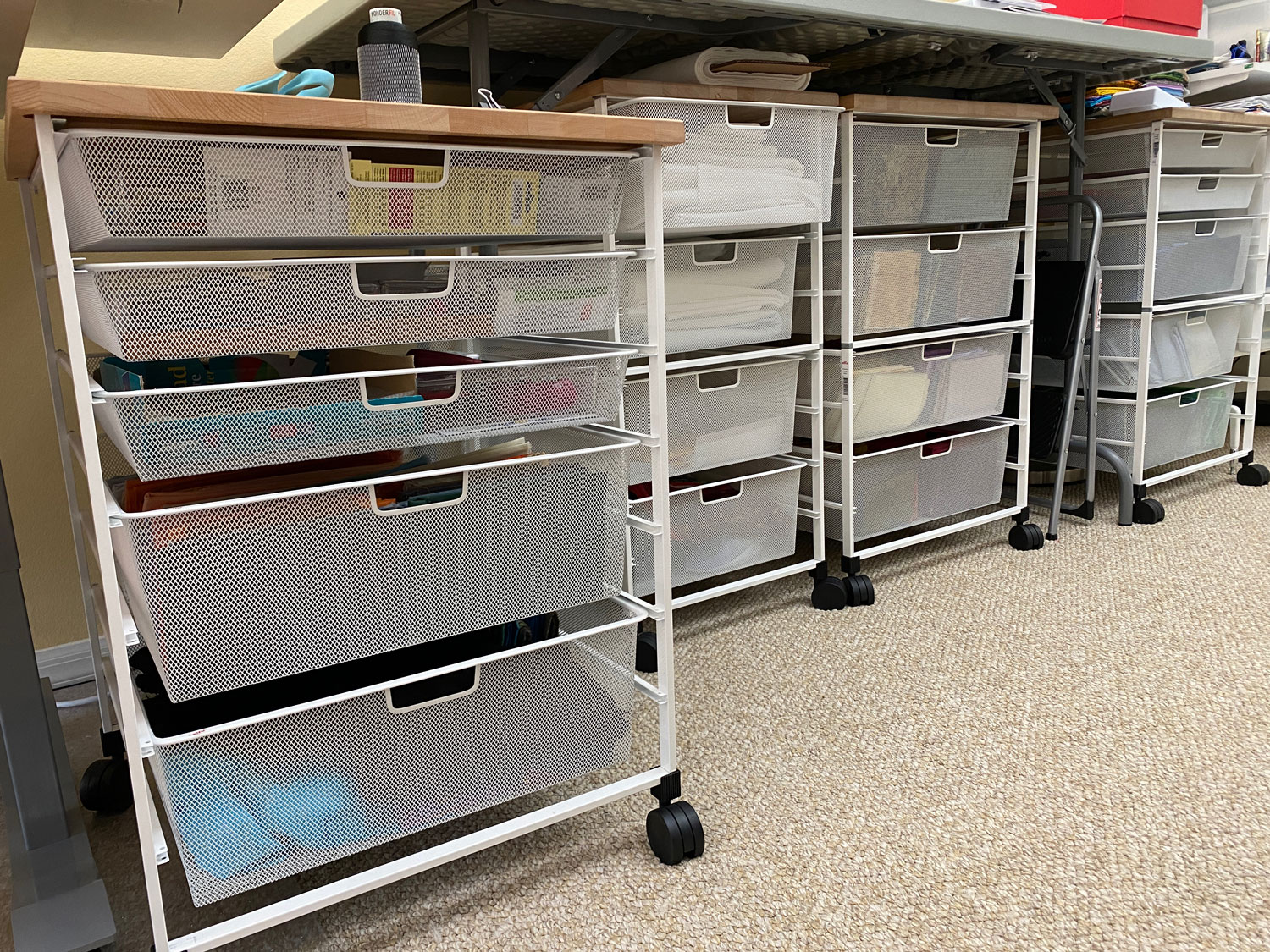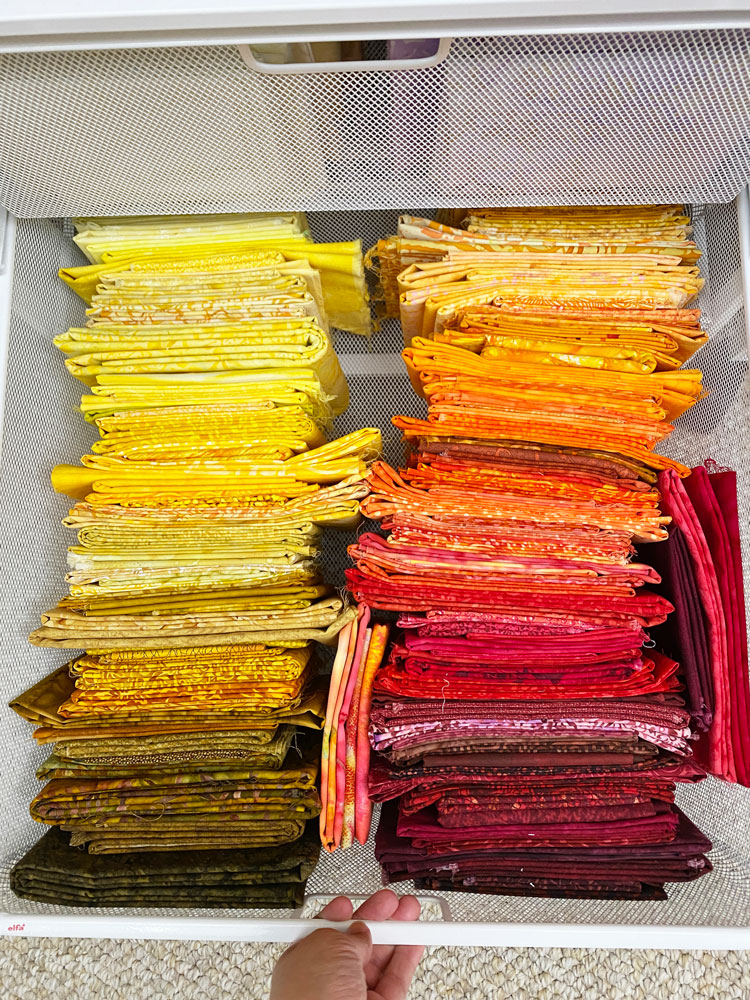Fabric Stash Insurance
- Published:
- Length: 992 words
- Reading Time: 5 minutes
It's pretty common for quilters to insure their sewing machines. Both of mine are insured for their MSRP against theft or loss. But there's another very valuable asset in every quilter's studio that has likely flown under the insurance radar: The Fabric Stash.
If you are at all like me, you've been accumulating fabric for years. I've been collecting since I started fabric art journey back in 2004. If — knock on wood — I lost my house in a fire, hurricane, or other natural disaster, I would very much like some monetary compensation to start rebuilding my fabric collection.
But how does one quantify a fabric stash? And if worse came to worst, how would I make a claim on the fabrics in my stash? That's what this blog post is all about.
Evaluating a stash
I considered, and discarded, several possible ways to calculate the fabrics in my stash before making my decision.
By Receipt: Calculating the value of my stash by adding up my receipts was my first thought. But there was just one problem: I don't have receipts for all of my fabric. I've got receipts from the past few years, but I started collecting in 2004. Furthermore, I no longer own the amount of fabric reflected on the receipt because a good bit of it has since ended up in quilts.
By Measurement: Measuring the amount of each fabric I own and calculating a total quantity would give me the most accurate result. But...that would take literal days. I have hundreds of fabrics, and each one would have to be unfolded, measured, re-folded, and stored. This was not a reasonable option for me simply due to the amount of time it would require.
By Weight: Every yard of material has a weight. The weight of 1 yard will vary by material (silk vs cotton, etc), but my stash consists entirely of quilting cottons, both prints and batiks. For insurance purposes, I didn't need to be incredibly accurate; a ballpark measurement would be good enough. So I decided to weigh my stash.
Weighing fabric
My fabric is stored in mesh, metal drawers in a series of ELFA drawer units.

I started by weighing myself holding an empty drawer. Then I weighed myself holding a drawer full of fabric. Subtract one from the other, and I was left with the weight of the fabric in that drawer.
(Kestrel + drawer + fabric) - (Kestrel + drawer) = fabric
I did this for every drawer of fabric and came up with 135 pounds of fabric. The average weight of 1 yard of quilting fabric is 5.5 ounces. So, next step was to convert my 135 pounds (lbs) of fabric into ounces (oz).
135lbs of fabric * 16oz per pound = 2160oz of fabric in my stash
Now all I had to do was divide that number by 5.5oz (the weight of 1 yard of fabric) to get the number of yards of fabric in my stash.
2160oz ÷ 5.5oz = 393 yards of fabric (rounded up)
To apply a value to that number, I once again used an average. I looked online at the types of batik and print fabrics I own and found they fall between $10-$14 per yard. So I calculated my stash at $12 per yard.
393 yards of fabric * $12 = $4713
That was good enough for State Farm, and I now have a $5000 rider on my homeowner's insurance specifically covering my fabric stash.
Take photos
As I documented the weight of each fabric drawer, I took a photo of that drawer, like this:

Photos will help me remember what I have, and will be helpful to provide to my insurance if I ever have to make a claim.
Making a claim
I've made it this far in life without having to make a homeowner's insurance claim – knock on wood — so I did some research on what that process looks like. I came across a comment on Reddit posted by someone who worked as an insurance adjuster, and it was pretty enlightening. I'm not one to believe everything I read online, but I asked my parents about what this person had to say (my parents have had to make homeowner's insurance claims before), and they agreed that this person's comments matched their experience dealing with insurance companies. So, I'm providing that comment here for your own perusal:
Insurance Adjuster Comment on RedditThe biggest takeaway from reading his comment is to be specific. The more specific itemized list I can provide to my insurance company, the more reimbursement I'll receive.
What does that mean for my stash? It would be impossible for me to itemize every individual fabric I own. But there are ways I can itemize my materials:
- Record any specific fabrics I care about deeply. (Quantity, brand, name of fabric)
- Record approximate amounts of brand name fabrics (ie. X yards of Kaufman batik fabric)
- Record backing fabric, as it's more expensive per yard than standard quilting cottons
- Record batting
- Record kind and quantity of any other special fabrics
The second takeaway from the above comment was that photos can be a good backup to prove I owned something, but should not be relied upon alone when making a claim. Remember to update your photos periodically.
Get an insurance rider
Last but not least, insure your stash (or any other individually valuable item, like a sewing machine or your artwork) under a separate insurance rider. It could be a fight with your insurance company to claim fabric or an expensive machine under a standard homeowner policy. Having those items covered under a dedicated rider will:
- Let your insurance know you own those items in advance
- Make it easier to get reimbursed for their loss since you'll be paying for coverage for those items specifically
